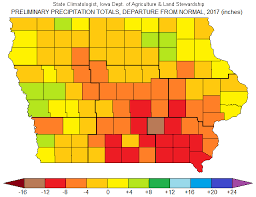2017 Drought
Mahaska county, Iowa
Oskaloosa and the rest of Mahaska County faced a severe drought in the summer of 2017. With an annual precipitation of 24.24 inches – nearly 14 inches less than the average – the local South Skunk River began to shrink. After previous years of flooding, the river was reduced to only 9% of its normal flow, the lowest measurement on record.
The South Skunk was not the only part of Mahaska County impacted by the drought. The farmers, who hadn’t seen rain since early May, were struggling with their crops.
Mark Jackson, a local farmer, commented on the lack of rain to the local newspaper. “I literally have had only one inch of rain since the third week in May. So here we are almost nine weeks later, my crop which typically takes an inch a week when it comes to a farm crop. So we’re working on, you might say, modern agriculturists techniques today.” Jackson is referring to hybrid crops that are engineered to withstand periods of drought.
“I think approximately 2012, so five years ago, we had an almost similar scenario where it quit raining somewhere right after we planted, around mid-May… But the root systems of the modern hybrids… of corn can go six, eight feet deep and follow the water table. And we did have a good water table going into the spring, so I think that’s a lot of it.”

While hybrids are helping limit the impact of drought, they are far from perfect. Soil type and water tables play an essential role in the growth of any crop. Jackson continued, “So yes, right now I predict a half a crop. Our typical yield would be 160 some bushels, that would be an average. I think last year 162 sounds like an average. My farm average last year was 200, just to give you an idea of where I am right now. So I am not optimistic by any means about having a bumper crop, or even an average crop at this point. It’s just a matter of maintaining what I have.”
Jackson noted there may still be hope for the soybeans. “If it doesn’t rain between now and harvest I would hate to think what the corn crop would be. The soybean crop really, the fill period is in August, so we still have a little more time.”
By August, the drought had not ended.
Sources: Ken Allsup,“Mahaska County Agriculture Dealing With Severe Drought Conditions,” Oskaloosa News, 2017; “Preliminary Iowa Annual Weather Summary,” Iowa Departmant of Agricultue and Land Stewardship, 2017; Deb Van Engelenhoven, “Drought is focus of meeting,” The Oskaloosa Herald, 2017.
